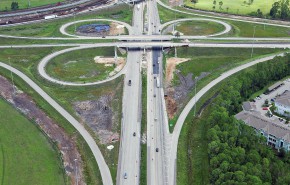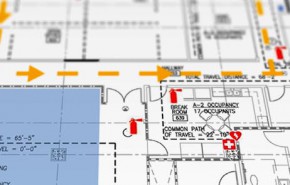Day or night, weekday or weekend, healthcare environments are in a constant state of flux, with emergency vehicles coming and going, critical situations at every turn, and visitors who often aren’t thinking clearly under stressful circumstances.
When it comes to hospitals and healthcare campus projects, one challenge is always present—healthcare campuses never shut down. And that is where Kathy Leo, PE, Director, Private Development and her team at GAI Consultants (GAI) come in—one might say successfully implementing designs on very active healthcare campuses is their niche.
Within healthcare campus environments, safety is a top concern, alongside functionality and uninterrupted operations.
Within healthcare campus environments, safety is a top concern, alongside functionality and uninterrupted operations. The campus must continue to function efficiently—“the ambulances, helicopters, and other emergency vehicles need uninterrupted access with their patients, unfamiliar visitors need to quickly access the hospital, and the daily, routine operations and deliveries of food, equipment, and supplies must be maintained,” Kathy points out.
So how does her team do it? What does it take to execute the visions of planners, doctors, hospital administrators, board members, and other stakeholders, while keeping safety, functionality, and uninterrupted operations at the forefront? “First and foremost, we’re cognizant of the ‘patient first environment’ that hospitals and their campuses are trying to create and maintain.” While keeping this in mind, Kathy shares a couple of the techniques her team uses to successfully construct healthcare campus design projects in these active environments.
Healthcare Campus Design—Phasing Project Construction for Round-the-Clock Operations
“Imagine a hypothetical scenario,” Kathy says, “A child breaks his arm and his parent is not necessarily thinking straight. They’re driving through the hospital campus. What if a street is closed? Where do they go? They can see the building where they need to be, but how do they get to it? This can be a very unnerving situation and can lead to extremely dangerous actions.”
To accommodate emergency circumstances like these and to avoid dangerous outcomes, “we go above and beyond to design and implement construction with multiple phases and provide wayfinding to safely maintain access and operations while accommodating construction,” says Kathy. Below she shares some successful techniques for phasing healthcare project construction:
- Allow for significant advanced planning for and evaluation of the campus’s existing operations and ongoing needs.
- Interview main stakeholders (e.g., facility operations, delivery services, and ambulance and emergency medical response teams and services) for every campus healthcare facility, because each has its own mode of operation and needs that could be affected.
- Identify critical access (e.g., vehicle, truck, delivery, emergency medical, pedestrian, shuttle, and bus) peak traffic times and other crucial operations.
- Create maintenance of traffic and business plans with detailed checklists for the specific healthcare campus and vet the plans with key stakeholders.
- Establish day, night, weekday, and weekend construction phasing.
- Generate a construction notification process and distribute this information via email, website, and/or flyers to stakeholders and identified parties—both internally (i.e., within the hospital organization) and to the public (e.g., area businesses and residents).
- Provide ongoing construction updates to identify phased closures and schedules, along with alternate traffic routes for all modes of traffic (e.g., vehicle, truck, delivery, shuttle, bus, bike, and pedestrian).
Healthcare Campus Design—Constructing Temporary Access Points
Sometimes a phased approach cannot be used due to safety and/or constructability concerns or other reasons identified in stakeholder meetings. In these situations, a second technique to successfully implement designs on active hospital campus environments is to construct temporary access points.
The benefits of the temporary access may far outweigh the costs associated with the temporary construction. Kathy explains, “We’ve actually constructed entire temporary roads, pathways, corridors, wayfinding, and lighting.” Below she elaborates on additional benefits associated with constructing temporary access points on active hospital campuses:
- Overall construction cost savings from allowing more efficient construction all at once instead of through multiple phases that start and stop.
- Expedited construction utilizing multiple shifts so facilities are reopened sooner.
- Added safety through the use of critical alternative access and pathways.
By implementing these and other techniques, GAI is able to successfully carry out stakeholder visions of healthcare campus expansion and beautification, while allowing these environments to safely function and operate continuously.
For questions or additional information about GAI’s healthcare campus design, planning, and construction services, contact Kathy Leo, PE at 321.436.8175. In Central Florida alone, GAI has partnered with Florida Hospital, Orlando Health, Health Central (now a division of Orlando Health), and South Lake Hospital (in affiliation with Orlando Health) on a number of noteworthy projects. Learn more about our healthcare industry clients, projects, and services.
For related information, check out the following article:
Five Trends in Healthcare | November 18, 2014


